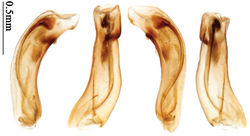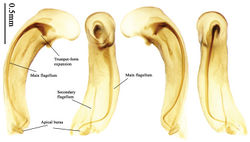Dasiosoma
| Notice: | This page is derived from the original publication listed below, whose author(s) should always be credited. Further contributors may edit and improve the content of this page and, consequently, need to be credited as well (see page history). Any assessment of factual correctness requires a careful review of the original article as well as of subsequent contributions.
If you are uncertain whether your planned contribution is correct or not, we suggest that you use the associated discussion page instead of editing the page directly. This page should be cited as follows (rationale):
Citation formats to copy and paste
BibTeX: @article{Shi2013ZooKeys284, RIS/ Endnote: TY - JOUR Wikipedia/ Citizendium: <ref name="Shi2013ZooKeys284">{{Citation See also the citation download page at the journal. |
Ordo: Coleoptera
Familia: Carabidae
Name
Dasiosoma Britton, 1937 – Wikispecies link – Pensoft Profile
- DasiosomaBritton 1937[1]: 233; Basilewsky 1949[2]: 221 (key to species); Basilewsky 1968[3]: 145.
- Teradaia Habu 1979a[4]: 65. Type-species: Teradaia bella Habu, 1979a, by original designation. Syn. n. [Synonym]
Type-species:
Dasiosoma testaceum Britton, 1937, by original designation.
Diagnosis
Dorsal side evenly pubescent, elytra with accessory setae on all intervals; labrum and outer scrobe of mandibles nearly glabrous; pronotum with basal foveae deep and narrow, forming a pair of deep grooves; elytral striae distinct, finely punctate; aedeagal internal sac with main flagellum developed, apex reaching the apical orifice, not projecting out from it.
Some species of the genus were placed in Lachnoderma by mistake (Bates 1883[5]; Tian and Deuve 2001[6]). These two genera may be closely allied, but Dasiosoma can be distinguished in having: (1) labrum and outer scrobe of mandibles nearly glabrous, at most labrum with a few very short fine accessory setae, but in Lachnoderma, labrum and mandibles always with long accessory setae, accessory setae on labrum as long as the six primary setae near apex; (2) mentum tooth simple, but bifid in Lachnoderma; (3) pronotum basal foveae much deeper and groove-like, but shallower and wide in Lachnoderma; (4) punctures in striae much finer than in Lachnoderma; (5) median lobe of aedeagus slender, apical bursa present, main flagellum not projected out from apical orifice, but Lachnoderma with median lobe of aedeagus stout, apical bursa absent, main flagellum projected out from apical orifice.
Generic characters
Dorsal side yellow, brown or piceous, elytra unicolored or bicolored, usually with weak metallic luster. Head densely pubescent, occiput and central area of clypeus nearly glabrous; eyes hemispherical, strongly prominent; tempora shorter or slightly longer than half length of eyes, abruptly or gradually narrowed behind eyes; vertex slightly or strongly tumid. Antennae extended to basal one-fifth of elytra; 1st antennomere slightly curved, 3rd slightly longer than 4th. Labrum slightly widened to apex, anterior margin straight or slightly curved, with faint microsculpture, glabrous or with a few very fine and short secondary setae; mandibles distinctly widened, outer margins rounded, glabrous on outer scrobe, with some setae arranged along dorsal ridge; terminal maxillary palpomeres fusiform in both sexes; terminal labial palpomeres strongly securiform, truncate apically in males, less widened in females; ligula with apex slightly projected, with four long setae and some short setae; paraglossae membranous, not longer than ligula, narrow, adnate; mentum tooth simple, short and rounded, with two long setae near base, sometimes with a few additional short setae; submentum with two long setae; genae with long setae beneath eyes; gula glabrous except apex. Pronotum wider than head; disc, lateral explanate areas and lateral margins densely and evenly pubescent; mid-lateral primary setae present, distinctly longer than accessory ones; basal foveae deep, forming a pair of deep grooves, extended anteriorly or anteriomedially; median line deep, reaching apical and basal margins; pronotal base more or less lobed; lateral margins rounded or narrowed in middle, more or less sinuate before hind angles; hind angles sharp, rectangular or acute, projected or not. Elytra slightly narrow, lateral margins parallel or expanded to apex; apex truncate, sutural angles not projected, outer angles completely rounded; basal margination reaching 3rd interval; basal pores large; striae shallow, distinct, finely punctate; intervals slightly convex; all intervals evenly pubescent, pubescence fine and long, erect; primary setigerous pores small, indistinct, with setae longer than erect pubescence, three or four pores on 3rd interval, one or two pores on base of 5th; 7th and 8th intervals slightly tumid near apex. Ventral side with long dense pubescence except posterior area of proepisterna, sparser on mesosternum and central area of metasternum; males with apex of terminal sternum moderately emarginate, with two pairs of setae, females straight or slightly emarginate, with two pairs of setae. Legs short; protibiae with cleaning spur well developed, distant from inner margin; tarsi widened, 4th tarsomere bifid, claws pectinate; males with adhesive hairs absent on all tarsomeres. Male genitalia with median lobe of aedeagus not twisted, strongly expanded and bent at base; strongly bent to right side in dorsal view; apical orifice opened apically; dorsal surface with a few fine setae subapically; internal sac with main flagellum slender, apex nearly reaching apical orifice, not projected out from it, trumpet-form expansion small; apical bursa present; secondary flagellum distinct. Female genitalia. Spermatheca tubular, with ring-sculpture, inserted on bursa copulatrix; spermathecal gland very short or longer than spermatheca, inserted near middle of spermatheca; spermatheca not bent. Apical segment of ovipositor scimitar-shaped, curved to outer side; apex sharp; apex with membranous extension short but sharp.
Distribution
South China, Indo-China Peninsula, South Asia, African mainland. Not discovered in the Philippines, Malay Archipelago or Madagascar.
Monophyly and relationships
Relationship between Dasiosoma and Lachnoderma is discussed under Lachnoderma. Monophyly of Dasiosoma is suggested by the following apomorphic character states: (1) basal foveae of pronotum deep and narrow; (2) median lobe of aedeagus strongly expanded and bent at base.
Taxonomic comments
Habu (1979a)[4] described the genus Teradaia for his new species Teradaia bella, and indicated that it is allied with Lachnoderma. But the Palaearctic catalogue (Löbl and Smetana 2003[7]) included Teradaia in Pericalina without explanation. We examined types of all four species from Africa belonging to Dasiosoma in the former concept, and dissected a paratype of Dasiosoma ivorense. The male genitalia (Fig. 86) are not significantly different from those of Teradaia bella and its allied species (Figs 87–90), and the small differences of external morphological characters between species from the two continents (see the key, first item) are not enough to be considered of genericlevel difference. So we herein synonymize Teradaia with Dasiosoma, and include Dasiosoma in Physoderina, not Pericalina.
Moreover, two Asian species (Singilis hirsutus Bates and Lachnoderma maindroni Tian & Deuve) that used to be placed in Lachnoderma, and also Diamella indica Kirschenhofer, are closer to Teradaia bella Habu than the other species of Lachnoderma or Diamella. So we combine these three species with Dasiosoma and describe a new species from Asia in the present paper. Thus the current concept of Dasiosoma includes nine species, with four of them from Africa, and the other five from Asia. The definitive characters of Dasiosoma are in the diagnosis.
The four Africa species (Dasiosoma testaceum Britton, 1937, Dasiosoma basilewskyi Shi & Liang nom. n., Dasiosoma sudanicum Basilewsky, 1949 and Dasiosoma ivorense Basilewsky, 1968) are very similar to each other. Two of them were described based each on a single female. Basilewsky (1949[2], 1968[3]) provided a key and diagnosis to these four species, but when we examined types of all four of these species, it is still difficult for us to clearly distinguish them all. So we leave this part of review work for future study when more material becomes available. In the present paper, we just revise the Asian fauna of Dasiosoma.
Key to species of Dasiosoma Britton
Taxon Treatment
- Shi, H; Zhou, H; Liang, H; 2013: Taxonomic synopsis of the subtribe Physoderina (Coleoptera, Carabidae, Lebiini), with species revisions of eight genera ZooKeys, 284: 1-129. doi
Other References
- ↑ Britton E (1937) New African Carabidae (Col.) including the description of a new genus. Proceedings of the Royal Entomological Society of London, Series B 6: 233-237.
- ↑ 2.0 2.1 Basilewsky P (1949) Coleopteres Carabidae africains nouveaux. II, III. Revue de Zoologie et de Botanique Africaines 41: 323-342.
- ↑ 3.0 3.1 Basilewsky P (1968) Descriptions de trois carabides nouveaux de Côte d’Ivoire. (Coleoptera Carabidae). Revue de Zoologie et de Botanique Africaines 77: 142-147.
- ↑ 4.0 4.1 Habu A (1979a) A new genus and species of the Lebiini from Formosa (Coleoptera, Carabidae). Proceedings of the Japanese Society of Systematic Zoology 16: 65-69.
- ↑ Bates H (1883) Supplement to the Geodephagous Coleoptera of Japan, chiefly from the collection of George Lewis, made during his second visit, from February, 1880, to September, 1881. The Transactions of the Entomological Society of London 1883: 205-290.
- ↑ Tian M, Deuve T (2001) Notes on the genus Lachnoderma Macleay, 1873, with descriptions of six new species from China and Vietnam (Coleoptera, Carabidae). Nouvelle Revue d’Entomologie 18 (2): 123-133.
- ↑ Löbl I, Smetana A (2003) Apollo Books, Denmark, 819 pp.
Images
|
![Figures 55–60. Type materials, scale bars = 2.0 mm: 55 Holotype of Dasiosoma sudanicum Basilewsky 56 Holotype of Dasiosoma ivorense Basilewsky 57 Holotype of Diamella indica Kirschenhofer [= Dasiosoma indicum (Kirschenhofer)] 58 Paratype of Lachnoderma maindroni Tian & Deuve [= Dasiosoma maindroni (Tian & Deuve)] 59 Lectotype of Singlis hirsutus Bates [= Dasiosoma hirsutum (Bates)] 60 The “lectotype” designated by Tian & Deuve, 2001 for Singlis hirsutus Bates.](https://species-id.net/o/thumb.php?f=ZooKeys-284-001-g010.jpg&width=250)
![Figures 61–66. Type materials, scale bars = 2.0 mm: 61 Holotype of Dasiosoma quadraticolle sp. n. 62 Lectotype of Endynomena lewisii Bates [= Orionella lewisii (Bates)] 63 Holotype of Orionella obenbergi Jedlička [= Orionella lewisii (Bates)] 64 Holotype of Endynomena discoidalis Bates [= Orionella discoidalis (Bates)] 65 Lectotype of Plochionus pradieri Fairmaire [= Endynomena pradieri (Fairmaire)] 66 Lectotype of Saronychium inconspicuum Blackburn [= Endynomena pradieri (Fairmaire)].](https://species-id.net/o/thumb.php?f=ZooKeys-284-001-g011.jpg&width=250)




